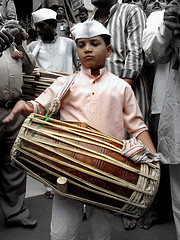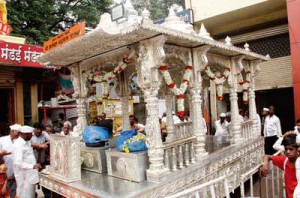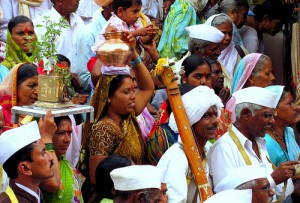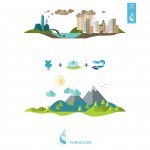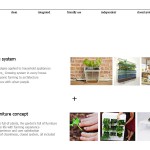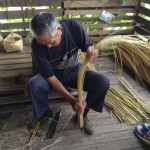Varkaris are the people who undertake the journey from their holy town to pandharpur.This journey is called vari and the people who perform this vari are called varkaris.This tradition is similar to kumbhmela where lakhs of people gather together for holy pilgrim.Its a 700 years old culture which has changed by times in many aspects.The first vari took place in 1291 from alandi to pandharpur.
There are no discriminations amongst the varkari on the basis of caste, creed, gender or class.Devotees of lord vitthal from Maharashtra and other states regularly participate in annual vari. Thousands of Warkaris walk to Pandharpur chanting the name of Vitthal, singing Bhajans, listening to Pravachan and Kirtan. Several foreign tourists come to watch the Wari of Vitthal and experience the unique tradition. They walk with flags on their shoulders with cymbals in their hands,mrudunga on their shoulders some times carrying Tulsi plant on their head.
It is an unparalleled phenomenon that breaks the barriers of caste, creed, rich and poor; which are so deeply rooted in the soceity. In exact words, if one has to describe how the atmosphere is in the Vari – it is ‘VitthalMay’ – filled in with Vitthal and thoughts of Vitthal.
Websites : http://warisantanchi.com
Three cultural probes topics
1.Mridunga
The images above show varkaris carrying mridunga while going to pvari.The 1st image shows a small varkari playing a mridunga made of wood which are heavy and bit difficult to carry.And as time has changed the same are being made of steel to ease the weight of instrument and more comfortable to take along.
2.Chariot
The chariot used to carry the padukas(footwear)in a palanquin are made of comprising carbon fiber, making it lighter in weight with a battery operated mould which will make it easy for the bullocks to pull it through steep stretches on the way.The earlier ones were of iron which made it difficult for the bullocks to carry along the stretch of 250kms.
3.Tulas
The varkari women carry the tulsi plant on their head which depicts it as laxmi. Earlier Tulsi plant were made of dark mud but due to its breakage property they are now made available in copper and aluminium metal.The metal ones are lighter in weight and easy to carry as compared to those made of mud.
